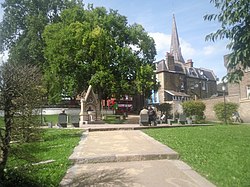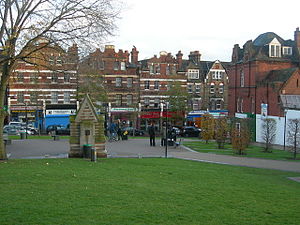Streatham: Difference between revisions
Created page with '{{Infobox town |name=Streatham |county=Surrey |picture=Streatham Green - geograph.org.uk - 2121932.jpg |picture caption=Streatham Green |os grid ref=TQ305715 |latitude=51.4279 |l…' |
m clean up, typos fixed: middle class families → middle-class families |
||
| Line 16: | Line 16: | ||
'''Streatham''' is a town in [[Surrey]], now deep within the metropolitan conurbation. | '''Streatham''' is a town in [[Surrey]], now deep within the metropolitan conurbation. | ||
Streatham is a place of contrasts, with middle class families occupying houses in leafy streets that fetch over £500,000 while there are large numbers of asylum seekers, predominantly from north and east African countries. | Streatham is a place of contrasts, with middle-class families occupying houses in leafy streets that fetch over £500,000 while there are large numbers of asylum seekers, predominantly from north and east African countries. | ||
In September 2002, Streatham High Road was voted the "Worst Street in Britain"<ref>{{Cite news|url=http://news.bbc.co.uk/1/hi/uk/2270840.stm|title=Britons name 'best and worst streets'|publisher=BBC | date=2002-09-20}}</ref> in a poll organised by the [[BBC]] ''Today'' programme and CABE. This largely reflected the dominance of through traffic along the High Road. It does at least remain a practical street. | In September 2002, Streatham High Road was voted the "Worst Street in Britain"<ref>{{Cite news|url=http://news.bbc.co.uk/1/hi/uk/2270840.stm|title=Britons name 'best and worst streets'|publisher=BBC | date=2002-09-20}}</ref> in a poll organised by the [[BBC]] ''Today'' programme and CABE. This largely reflected the dominance of through traffic along the High Road. It does at least remain a practical street. | ||
Streatham Festival was founded in 2002<ref>[http://www.streathamfestival.com/ Streatham Festival]</ref> | Streatham Festival was founded in 2002.<ref>[http://www.streathamfestival.com/ Streatham Festival]</ref> It has grown to a festival with over 50 events held in an array of locations, from bars to churches and parks to youth centres, attracting over 3,000 people. | ||
After several years of delay and controversy over phasing, construction started in the autumn of 2011 on the ''Streatham Hub'' - a major redevelopment next to Streatham station. | After several years of delay and controversy over phasing, construction started in the autumn of 2011 on the ''Streatham Hub'' - a major redevelopment next to Streatham station. | ||
Latest revision as of 22:48, 28 January 2016
| Streatham | |
| Surrey | |
|---|---|
 Streatham Green | |
| Location | |
| Grid reference: | TQ305715 |
| Location: | 51°25’40"N, 0°7’25"W |
| Data | |
| Post town: | London |
| Postcode: | SW16, SW2 |
| Dialling code: | 020 |
| Local Government | |
| Council: | Lambeth |
| Parliamentary constituency: |
Streatham |
Streatham is a town in Surrey, now deep within the metropolitan conurbation.
Streatham is a place of contrasts, with middle-class families occupying houses in leafy streets that fetch over £500,000 while there are large numbers of asylum seekers, predominantly from north and east African countries.
In September 2002, Streatham High Road was voted the "Worst Street in Britain"[1] in a poll organised by the BBC Today programme and CABE. This largely reflected the dominance of through traffic along the High Road. It does at least remain a practical street.
Streatham Festival was founded in 2002.[2] It has grown to a festival with over 50 events held in an array of locations, from bars to churches and parks to youth centres, attracting over 3,000 people.
After several years of delay and controversy over phasing, construction started in the autumn of 2011 on the Streatham Hub - a major redevelopment next to Streatham station.
Churches
"Twin spires" at the centre of Streatham are visible from the top of Streatham Common; the rival steeples of St Leonards (Church of England) and English martyrs (Roman Catholic). The churches of Streatham go beyond these two though and include:
- Church of England
- Baptist:
- Methodist: Streatham Methodist Church
- New Covenant: New Covenant Church
- Roman Catholic:
Other religions
- Jewish synagogues:
- South London Liberal Synagogue (Liberal)
- Muslim mosques:
History
Streatham means "the hamlet on the street"; the Roman road which now forms the High Street. The road is confusingly referred to as Stane Street in some sources, although it diverges from the main London-Chichester road, which properly bears that name, at Kennington.
After the departure of the Romans, the main road through Streatham remained an important route. From the seventeenth century it was adopted as the main coach road to Croydon and East Grinstead, and then on to Newhaven and Lewes. In 1780 it then became the route of the turnpike road from London to Brighton, and subsequently became the basis for the modern A23. This road (and its traffic) have shaped Streatham's development.
Streatham's first parish church, St Leonard's, dates back to Anglo-Saxon times, although only the mediæval tower remains in the present church. The mediæval parish covered an extensive area, including most of modern Balham and parts of Tooting.
Streatham appears in Domesday Book of 1086 as Estreham. It was held by Bec-Hellouin Abbey (in Normandy) from Richard de Tonbrige. Its domesday assets were: 2 hides and 1 virgates; 6½ ploughs, 4 acres of meadow, and herbage. It rendered £4 5s 0d.[3]
The village remained largely unchanged until the 18th century, when the village's natural springs, known as Streatham Wells, were first celebrated for their health giving properties. The reputation of the spa, and improved turnpike roads, attracted wealthy City of London merchants and others to lay out their country residences in Streatham. Few of these large houses still remain, as the area was rapidly urbanised as London expanded.
Streatham Park or Streatham Place
In the 1730s, Streatham Park, a Georgian country mansion, was built by the brewer Ralph Thrale on land he bought from the Lord of the Manor, the Fourth Duke of Bedford. Streatham Park later passed to Ralph's son Henry Thrale, who with his wife Hester Thrale entertained many of the leading literary and artistic characters of the day, most notably the lexicographer Samuel Johnson. The dining room contained 12 portraits of Thrale| guests painted by his friend Joshua Reynolds. These pictures were wittily labelled by Fanny Burney as the Streatham Worthies.
Streatham Park was later leased to the Prime Minister Lord Shelburne, and was the venue for early negotiations with France that lead to the Peace Treaty of 1783. Streatham Park was demolished in 1863.
Park Hill
One large house which survives is Park Hill, on the north side of Streatham Common, rebuilt in the early 19th century for the Leaf family. It was latterly the home of Sir Henry Tate, sugar refiner, benefactor of local libraries across south London, including Streatham Library, and founder of the Tate Gallery at Millbank.
Urbanisation
Development accelerated after the opening of Streatham Hill railway station on the West End of London and Crystal Palace Railway in 1856. The other two railway stations followed within fifteen years.
Some estates, such as Telford Park to the west of Streatham Hill were spaciously planned with facilities such as tennis clubs. Other streets adopted more conventional suburban layouts. Three more parish churches were built to serve the growing area, including Immanuel and St Andrews (1854), St Peter (1870) and St Margaret the Queen (1889).
There is now a mixture of buildings from all architectural eras of the past 200 years.
The inter-war period
Between the First World War and the Second World War Streatham developed as location for entertainment, with Streatham Hill Theatre (now a bingo hall), three cinemas, the Locarno ballroom (latterly Caesar's nightclub which closed in 2010) and Streatham Ice Rink all adding to its reputation as "the West End of South London". With the advent of electric tram services it also grew as a shopping centre serving a wide area to the south. In the 1930s large numbers of apartment blocks were constructed along the High Road. These speculative developments were not initially successful. They were only filled when émigré communities began to arrive in London after leaving countries under the domination of Hitler's Germany. In 1932 the parish church of the Holy Redeemer was built in Streatham Vale to commemorate the work of William Wilberforce.[4]

Nearest stations
- Norbury
- Streatham Common
- Streatham Hill
- Streatham
Outside links
- Streatham Pulse - a local website and blog providing a guide to the area
- Streatham Guardian - Streatham's local newspaper
- The Streatham Society - local amenity society with active local history group
- Streatham Action - formerly known as Streatham Community Forum
- The Streatham Festival - annual arts festival
- Streatham - A 19th Century Dormitory Suburb - history of Suburban Streatham by Graham Gower
- Images of Streatham on Lambeth Landmark
- Telford Park Estate history
- Streatham Park - description on Thrale.com - Thrale family history site